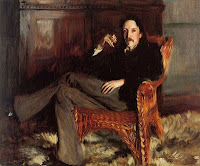It’s
old news that too much sedentary activity can pose health risk. Yet that was
the thrust of a recent newspaper story (in the London Independent). Among the scary conditions cited: heart
disease, blood clots on the brain, even certain types of cancer.
The
article’s cautionary focus is directed to the modern legion of desk workers.
It's only way down in the fourteenth paragraph that the focus narrows to a particular
sedentary class—writers.
What writers need to do, apparently, is quite simple: Crank up their desks to lectern
height.
By
way of encouragement, the article cites a distinguished quartet of stand-up writers—Hemingway,
Nabokov, Solzhenitsyn, Churchill. The only living example offered is, oddly, Don
Rumsfeld.
But
writers, when they confront the blank page, on paper or screen, are they obsessed
with health and fitness? Hardly. Their obsession is trying to plug into
the nearest Muse. Performance enhancing drugs are not limited to athletes, after
all; if they could be assured of hitting it out of the park, many writers would
gladly dice with the Devil, and many have.
So
here’s my more persuasive argument for writing on one’s feet. It
invigorates the process of composition. More blood to the brain equals more
muscular prose, something like that.
It’s
especially true of fiction-writing, especially for that first draft. As one
writer exhorted me early on:
- Write with physical energy and strong emotion.
- Get the raw pigment down on the canvas (to use an analogy).
- Write in a state of excitement.
(The
teacher was William Foster-Harris at the University of Oklahoma, whose successful
students included Louis L’Amour, Mary Higgins Clark and Tony Hillerman. His out-of-print primer on plotting is well worth searching for.)
Leon
Martell, a contemporary playwright and actor,
once offered a UCLA Extension course called “Writing Below the Neck: A Theatrical Approach to
Creating Characters.” I never took
Mr. Martell’s course, but I was intrigued by the catalogue description:
“To
get past the intellectual in the writer, to reach what is spontaneous and
visceral in a character, Leon Martell works with exercises originally created
for actors which have been adapted to help writers work from the inside out.”
Fiction
writers need to be actors, obviously, to get inside their characters. In the
words of Georges Simenon cited in an earlier post, “All the day I am one of my
characters. I feel what he feels.” Flaubert is supposed to have experienced symptoms of arsenic poisoning when
writing of Madame Bovary’s death.
Writing
with strong and sympathetic emotion requires a great deal of physical
energy. To prime the pump, many fiction writers (just like actors) do vigorous
warmup exercises before sitting, or standing, to begin their work. In his early
years, John D.MacDonald did pushups and situps prior to his daily stint.
My
own first fiction sales, at five cents a word, were to confession magazines, True
Romance and True Story. They were first-person stories from the female
perspective, following a plot formula carved in stone—Sin, Suffer and Repent. There
were many additional editorial commandments, one of which I have never forgotten:
Every paragraph must be infused with strong emotion.
I
don’t remember if I did pushups before launching into the first-draft of “Can’t
Anyone Hear Me Crying,” my first sale, but I was certainly energized, and, yes,
I was sobbing along with my POV character by the end.
As
for writing on one’s feet, I’m surprised that the London Independent article
omitted the venerable practice of dictation. Erle Stanley Gardner, author of
Perry Mason stories (and hundreds more under a host of pen names) “dictated his
detective novels nonstop to a series of secretaries, having previously pasted
about in his studio 3-by-5 cards reminding him at exactly what hour the dog
barked, the telephone rang, the murderer coughed.” (William F. Buckley Jr.,
“What’s So Bad About Writing Fast?” New York Times Book Review, Feb. 9, 1986.)
For
his first drafts, Sidney Sheldon reportedly paced in front of a secretary who took
shorthand at 220 words a minute.
A
more distinguished (and probably slower) dictator was Robert Louis Stevenson. There
are accounts of RLS, at his hilltop house in Samoa toward the end of his life,
acting out all the parts, male and female, as he improvised scenes from St.
Ives and the unfinished Weir of Hermiston.
Whenever
C.S. Forester, author of the Hornblower Saga and The African Queen, encountered a
particularly knotty problem in a story or scene, he would pace his study until
the matter resolved itself. Forester also recounts (in The Hornblower
Companion, Pinnacle Books, 1964) the all-consuming nature of his creative
process, in which he could visualize all his characters to the extent that he
could walk around them as on a stage and view them from all angles.
Two
more quotes to round out this brief discussion on the proper physical attitude
for writing. First, from a wonderful writer who neither sat nor stood, Truman
Capote:
“I
am a completely horizontal author. I can’t think unless I’m lying down, either
in bed or stretched on a couch and with a cigarette and coffee handy. I’ve got
to be puffing and sipping. As the afternoon wears on, I shift from coffee to
mint tea to sherry to martinis.”
(Writers
at Work: The Paris Review Interviews, p. 294.)
And
a parting shot from John D. MacDonald in defense of the seat-of-the-pants
technique (while flouting all the health risks thereof):
"Get
the fissures in the piles and the varicosities and the pressures on the disks
and keep the ass on the chair and do it!"
(Quoted
in John D. MacDonald by Davod Geherin)
*





















Flexi Solutions offer a range of customised height adjustable desks for use in the workplace, education and the healthcare industry.
ReplyDeletemore information then visit: http://www.flexi-solutions.com.au
pneumatic height adjustable desk